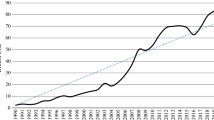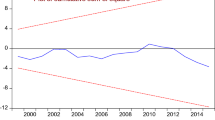Abstract
Savings is considered to be a principal determinant to achieve long-run economic growth. Remittances and foreign aid are two important foreign capital inflows to meet the savings deficiency of developing nations. The objective of this study is to investigate the long-run impact of remittance to stimulate savings in remittance recipient countries. This paper contributes to the macroeconomic impact of remittance through a comparative study on Bangladesh, India and Philippines that positioned among the top ten largest remittance recipient countries from 2008 and onwards. The analysis makes use of an annual time series data over the period of 1980–2015. The Johansen cointegration test suggested long-run cointegrating relationship of remittance and foreign aid on gross savings. The test result suggests positive effect of remittances on gross savings for Bangladesh and Philippines although an insignificant negative effect for India. However, foreign aid has significant negative long-run impact in all the three cases. Government policy should focus on leveraging remittance flows to facilitate savings and investment for capital accumulation.
Similar content being viewed by others
Notes
The two gap model for economic development is a significant addition to the economic growth theory from the study of Chenery and Bruno (1962), McKinnon (1964), Chenery and Strout (1966) and Weisskopf (1972). This model explains the interrelation between savings scarcity and dearth of foreign exchange reserve for economic growth of developing countries.
Emigration data in this paragraph were taken from ‘Migration and Remittance Facebook 2016’ (third edition) and remittance earning data were quoted from ‘Migration and Development Brief, 27’; both published by World Bank Group. Other data have been calculated from World Bank development indicator database.
This international system is applied by both the OECD and the United Nations for recording national account data for comparability purpose.
Net savings is savings after adjustment for depreciation.
References
Adams JRH (1991) The economic uses and impact of international remittances in rural Egypt. Econ Dev Cult Change 39(4):695–722
Adams JRH (2002) Precautionary saving from different sources of income: evidence from rural Pakistan. Policy Research Working Paper 2761. World Bank, Washington, DC
Adams JRH (2006) International remittances and the household: analysis and review of global evidence. J Afr Econ 15(2):396–425. https://doi.org/10.1093/jafeco/ejl028
Adelman I, Chenery HB (1966) The foreign aid and economic development: the case of Greece. Rev Econ Stat 48(1):1–19
Azad AK (2005) Migrant workers’ remittances: a source of development finance for microenterprise development in Bangladesh? In: Samuel MM, Ratha D (eds) Remittances: development impacts -and future prospects. World Bank, Washington. https://doi.org/10.1596/0-8213-5794-8
Bajaras A, Chami R, Fullenkamp C, Gapen M, Montiel PJ (2009) Do workers’ remittances promote economic growth? IMF Working Papers 9(153):1–22
Balassa B (1989) The effects of interest rates on savings in developing countries. Policy, Planning and Research Department working papers no. WPS 56. World Bank, Washington, DC
Balde Y (2011) The impact of remittances and foreign aid on savings/investment in Sub-Saharan Africa. Afr Dev Rev 23(2):247–262. https://doi.org/10.1111/j.1467-8268.2011.00284.x
Basnet HC (2013) Foreign aid, domestic savings, and economic growth in South Asia. Int Bus Econ Res J 12(11):1389–1394. https://doi.org/10.19030/iber.v12i11.8176
Blades DW, Sturm PH (1982) The concept and measurement of savings: the United States and other industrialized countries. In: Saving and Government Policy, Conference Series, no 25, pp 1–30
Bowles P (1987) Foreign aid and domestic savings in less developed countries: some tests for causality. World Dev 15(6):789–796. https://doi.org/10.1016/0305-750X(87)90060-X
Burnside C, Dollar D (2000) Aid, policies, and growth. Am Econ Rev 90(4):847–868
Catrinescu N, Leon-Ledesma M, Piracha M, Quillin B (2009) Remittances, institutions, and economic growth. World Dev 37(1):81–92. https://doi.org/10.1016/j.worlddev.2008.02.004
Chami R, Fullenkamp C, Jahjah S (2005) Are immigrant remittance flows a source of capital for development? IMF Staff Papers 52(1):55–81
Chenery HB, Bruno M (1962) Development alternatives in an open economy: the case of Israel. Econ J 72(285):79–103
Chenery HB, Stout A (1966) Foreign assistance and economic development. Am Econ Rev 55:679–733
Chiodi V, Jaimovich E, Montes-Rojas G (2012) Migration, remittances and capital accumulation: evidence from rural Mexico. J Dev Stud 48(8):1139–1155
Connell J, Conway D (2000) Migration and remittances in island microstates: a comparative perspective on the South Pacific and the Caribbean. Int J Urb Reg Res 24(1):52–78. https://doi.org/10.1111/1468-2427.00235
Cota JEM, Gonzalez ED (2008) Are remittances a source of saving and investment in Mexico? A regional analysis of the households’ behavior. Papeles Poblac 14(56):37–65
Das A, Serieux J (2010) Remittances and reverse flows in developing countries. IDEAs Working Paper Series 2. Center for Global Development, Washington, DC
De-Arcangelis G, Joxhe M (2015) How do migrants save? Evidence from the British household panel survey on temporary and permanent migrants versus natives. IZA J Migr 4(1):11
Dickey DA, Fuller WA (1979) Distribution of the estimators for autoregressive time series with a unit root. J Am Stat Assoc 74(366a):427–431
Domar ED (1946) Capital expansion, rate of growth, and employment. Econometrica (J Econom Soc) 14(2):137–147
Fry MJ (1980) Saving, investment, growth and the cost of financial repression. World Dev 8(4):317–327. https://doi.org/10.1016/0305-750X(80)90030-3
Fry MJ, Mason A (1982) The variable rate of growth effect in the life cycle saving model. Econ Inq 20(3):426–442. https://doi.org/10.1111/j.1465-7295.1982.tb00359.x
Gani A (2016) Remittances and savings in Asia: some empirical evidence based on the life-cycle model. J Finance Econ 4(1):24–38. https://doi.org/10.12735/jfe.v4i1p24
Giovannini A (1985) Savings and the real interest rate in LDCs. J Dev Econ 18(2–3):197–217. https://doi.org/10.1016/0304-3878(85)90054-9
Giuliano P, Ruiz-Arranz M (2005) Remittances, financial development, and growth. Working Paper no. 5-234. International Monetary Fund
Griffin K (1973) The effect of aid and other resource transfers on savings and growth in less developed countries: a comment. Econ J 83(331):863–866. https://doi.org/10.2307/2230676
Griffin K, Enos JL (1970) Foreign assistance: objectives and consequences. Econ Dev Cult Change 18(3):313–327. https://doi.org/10.1086/450435
Grinols E, Bhagwati J (1979) Foreign capital, savings and dependence: a reply to Mr. Wasow. Rev Econ Stat 61(1):154–156. https://doi.org/10.2307/192484
Harrod RF (1939) An essay in dynamic theory. Econ J 49(193):14–33
Hossain B (2014a) The effect of foreign aid on the economic growth of Bangladesh. J Econ Dev Stud 2(2):93–105
Hossain D (2014b) Differential impacts of foreign capital and remittance inflows on domestic savings in developing countries: a dynamic heterogeneous panel analysis. Econ Rec 90(s1):102–126. https://doi.org/10.1111/1475-4932.12114
Iqbal Z, Rehman QN (1995) Constraints to the economic growth of Pakistan: a three-gap approach [with comments]. Pak Dev Rev 34(4):1119–1133
Islam A, Parasnis J, Fausten D (2013) Do immigrants save less than natives? Immigrant and native saving behaviour in Australia. Econ Rec 89(284):52–71. https://doi.org/10.1111/1475-4932.12000
James G, Witten D, Hastie T, Tibshirani R (2017) An introduction to statistical learning, 8th edn. Springer, New York
Johansen S (1991) Estimation and hypothesis testing of cointegration vectors in Gaussian vector autoregressive models. Econ J Econ Soc 59(6):1551–1580
Kaberuka W, Namubiru R (2014) The effect of remittances on gross domestic savings in Uganda. Int J Bus Manag Adm 3(2):29–39
Kapur D, McHale J (2003) Migration’s new payoff. Foreign Policy 139:48–57. https://doi.org/10.2307/3183737
Karagoz K (2009) Workers’ remittances and economic growth: evidence from Turkey. J Yasar Univ 4(13):1891–1908
Lipton M (1980) Migration from rural areas of poor countries: the impact on rural productivity and income distribution. World Dev 8:1–24. https://doi.org/10.1016/0305-750X(80)90047-9
Loayza N, Schmidt-Herbel K, Serven L (2000) What drives private saving across the world? Rev Econ Stat 82(2):165–181. https://doi.org/10.1162/003465300558678
Malik SJ, Sarwar N, Siddiqui R (1993) Some tests for differences in consumption patterns: the impact of remittances using household income and expenditure survey data of Pakistan 1987–88. Pak Dev Rev 32(4):699–711
Massey DS, Alarcón R, Durand J, González H (1987) Return to Aztlán: the social process of international migration from Western Mexico. Univ California Press, Berkeley
McKinnon RI (1964) Foreign exchange constraints in economic development and efficient aid allocation. Econ J 74(294):388–409
Modigliani F (1970) The life-cycle hypothesis and inter-country differences in the saving ratio. In: Eltis WA, Scott FR, James NW (eds) Induction, growth, and trade. Oxford University Press, Oxford
Morton J, Panday P, Kula M (2010) Remittances, poverty and economic growth. Int J Arts Sci 3(7):390–399
Özcan KM, Gunay A, Ertac S (2003) Determinants of private savings behaviour in Turkey. Appl Econ 35(12):1405–1416
Philips PCB, Perron P (1988) Testing for a unit root in time series regression. Biometrika 75(2):335–346. https://doi.org/10.1093/biomet/75.2.335
Quinn MA (2005) Remittances, savings, and relative rates of return. J Dev Areas 38(2):1–23
Ratha D (2006) Trends, determinants, and macroeconomic effects of remittances. In: Ratha D, Shaw W, Dadush U, Burns A, Van-Der Mensbrugghe D (eds) Global economic Prospects: economic implications of remittances and migration. The World Bank, Washington, pp 85–112
Reichel R (1995) Development aid, savings and growth in the 1980s: a cross section analysis. Sav Dev 19(3):279–296
Sabra MM (2016) Remittances impact on economic growth, domestic savings and domestic capital at the presence of ODA and FDI in selected MENA countries. Int J Econ Manag 5(1):36–54. https://doi.org/10.6007/IJAREMS/v5-i1/2135
Sabra MM, Sartawi S (2015) Development impacts of foreign aid on economic growth, domestic savings and dutch disease presence in Palestine. Int J Econ Res 3(11):532–542
Saltz IS (1999) An examination of the causal relationship between savings and growth in the third world. J Econ Finance 23(1):90–98
Solow RM (1956) A contribution to the theory of economic growth. Q J Econ 70(1):65–94
United Nations (2009) System of National Accounts, 2008. New York
United Nations (2016) International Migration Report 2015: highlights (ST/ESA/SER.A/375). United Nations, Department of Economic and Social Affairs, Population Division
WDI (2017) World Development Indicator dataset. The World Bank. http://data.worldbank.org/indicator/ as on 30 May 2017
Weisskopf ET (1972) The Impact of foreign capital inflow on domestic savings in underdeveloped countries. J Int Econ 2:25–38
Acknowledgements
The present research paper is based on the Ph.D. thesis work of the author. This research was supported by scholarship from RYMF (Rotary Yoneyama Memorial Foundation) a project of the rotary districts of Japan. The authors are grateful to Masaki Nakahigashi, Shutaro Muto and Kozo Ishikawa for their useful discussion and advice.
Funding
This research was supported by scholarship from RYMF (Rotary Yoneyama Memorial Foundation) a project of the rotary districts of Japan (Grant Number RY034256).
Author information
Authors and Affiliations
Corresponding author
Ethics declarations
Conflict of interest
The author declares that she has no conflict of interest.
Ethical standards
The study has been conducted in compliance with the ethical standards.
Rights and permissions
About this article
Cite this article
Akter, S. Do remittances and foreign aid augment the gross savings: Bangladesh, India and Philippines perspective?. Int Rev Econ 65, 449–463 (2018). https://doi.org/10.1007/s12232-018-0305-z
Received:
Accepted:
Published:
Issue Date:
DOI: https://doi.org/10.1007/s12232-018-0305-z




